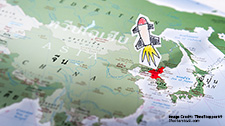Pivotal States, Global South and India-South Korea Relations

Choong Yong Ahn and Jagannath P. Panda
- In recent years, the term “Global South”—largely spanning countries in Africa, Central and Latin America, Asia, and the Caribbean—has gained tremendous geopolitical currency. One of the most salient drivers of this reclamation of the so-called emerging and developing world as a symbolic power has been India’s rising strategic and diplomatic prominence.
- As a vocal member of the community of diverse states, India has refocused its efforts to place the South and its concerns at center stage by coalescing with “like-minded” partners, which was effectively reflected during the 2023 G20 presidency. South Korea is an integral aspect of this global aim.
- Notwithstanding South Korea’s lack of an official endorsement of the term Global South, South Korea’s commitment in policy to foster a prosperous global community through shared global development certainly envisages an inclusive vision. Its current ambition to become a “global pivotal state” has only ensured the advancement of this developmental goal.
- Moreover, as a former aid recipient and today’s advanced economy, it has also become an exemplary global economic and social development model. Thus, South Korea’s voice is pivotal in matters related to the Global South.
- Together, South Korea and India can help forge a more equitable global governance system by working together to minimize differences; promoting the interests of the Global South; and advocating for reforms, particularly in multilateral forums, that would make these forums more equitable and democratic.
- In South Korea’s quest to be a global pivotal state in the new Indo-Pacific construct, India has emerged as a key strategic partner in providing a new impetus to Korea’s geopolitical and economic ambitions on a global scale. Both India and South Korea can play an important role in the Indo-Pacific construct based on a common strong security relationship with the United States and on shared democratic values in realizing their sustainable development agenda through minilateral and multilateral frameworks.
- At the same time, it is also important to examine the rationale of the Yoon government’s “global pivotal state” rhetoric, particularly in the context of taking a longer-term approach to building South Korea-India relations. South Korea needs to build a domestic constituency that supports the India-Korea bilateral relationship in the longer term. To do this, it needs to go beyond the rhetoric.
- Notwithstanding the ambitious goal, South Korea’s absence from key minilateral groups has led to questions regarding the country’s actual influence and importance in global affairs. Yoon’s steps have also led to South Korea’s stronger alignment with Western liberal democracies, which comes with potential risks. In addition, South Korea’s geopolitical turn has not been bold enough: Seoul is still engrossed with Pyongyang’s nuclear threat, whereas other issues of the Indo-Pacific remain marginal.
- South Korea must not overlook that its middle power status is vulnerable, and so must actively seek to broaden its global engagements to bolster its international political influence and ensure a secure future. Embracing a more proactive and inclusive diplomatic approach will be crucial for South Korea to navigate the evolving global landscape and to effectively address the challenges and opportunities that lie ahead.
- For example, South Korea can utilize its robust economy to elevate its diplomatic standing by actively cooperating in areas like green growth, blue economy initiatives, digital trade, and increasing Official Development Assistance to support countries in need and its partner nations. Such actions will contribute to elevating South Korea’s diplomatic influence and international reputation.
- In terms of the India-Korea bilateral, despite figuring within the top ten economies in global sweepstakes, their economic engagement and interchange is arguably slender and relatively tepid. Seoul’s underwhelming footprint within India’s infrastructure building is in stark contrast to Japan, which has a robust presence in financially and logistically underwriting some of India’s iconic infrastructure projects. South Korea also needs to leverage its broad spectrum of multi-sectoral and multi-dimensional competencies in capacity-building and capability-enhancement initiatives in developing societies.
- Nevertheless, Korea’s embrace of the Strategy for a Free, Peaceful, and Prosperous Indo-Pacific marks an inflection point of sorts in tandem with the ideation of a global pivotal state, carrying refreshing dimensions that could be enterprisingly productive. If India and South Korea shed mutual inhibitions and endeavor to purposefully translate complementarities into operative synergies, they can deepen their natural convergence.
- Beyond the bilateral, an area of multilateral connect is South Korea’s potential role within the Quadrilateral Security Dialogue (Quad) Plus framework, particularly in supply chain diversification for aiding global growth via the influence of the Korea Inc. By leveraging its diplomatic acumen, economic strength, and technological advancements, South Korea can contribute to international problem-solving and bridge the gap between developed and developing nations.
- At the heart of South Korea’s ascent to a potential global pivotal state lies the collective force of “Korea Inc,” which can leverage its global economic influence, technological innovation, and extensive supply chain networks. Its diversified operations across industries and international markets align with the “Quad Plus” objectives of fostering stability, resilience, and sustainable development in the Indo-Pacific region and beyond.
- Importantly, it provides an opportunity to diversify some of the most important supply chains away from unipolar sources such as China, especially as many of these chaebols have already implemented such efforts. At the same time, despite their criticality for South Korea, questions remain whether the chaebols will be able to adapt to the changing economic landscape and maintain their dominance in the South Korean economy.
- Moreover, South Korea and India need to expand their collaborative efforts by engaging with the Association of Southeast Asian Nations (ASEAN). Seoul and New Delhi should increase their engagement in third-party countries located in Southeast Asia, as well as promote Korea-ASEAN-India trilateral cooperation.
- They should create synergies between the Indo-Pacific strategy, the Act East Policy, and the ASEAN Outlook on the Indo-Pacific by utilizing the existing ASEAN-led multilateral and other multilateral and subregional cooperation platforms.
- The four potential areas of cooperation are as follows: (1) Institutionalization of the India-ASEAN-ROK trilateral dialogue platform, (2) maritime cooperation, (3) cooperation for enhancing connectivity, and (4) economic and technology cooperation.
- The Korea-ASEAN-India trilateral can help in responding to emerging regional and global challenges through more flexible, inclusive, and issue-driven multilateral cooperation.
- In terms of synergizing middle power diplomacy in the Indo-Pacific, India, Japan, and South Korea should align interests and capabilities toward deliverable and sustainable foreign policy coordination. They need to cooperate proactively and pragmatically to secure their national interests in order to avoid being shaped by the U.S.-China strategic competition.
- To accomplish such objectives, they could use their collective comparative advantages to develop new sustainable and meaningful initiatives. These could be enabled via stand-alone trilateral cooperation or by plugging into existing minilateral or multilateral forums such as AUKUS (the Australia-UK-U.S. defense pact), the Indo-Pacific Economic Framework for Prosperity (IPEF), and the Quad.
- At the same time, such multifaceted cooperation goals will need to factor in that the India-South Korea strategic relationship still remains somewhat limited. Nevertheless, the growth in the India-South Korea bilateral and the emerging strategic dimensions of their interactions point to the immense importance Delhi places on Seoul as an equal partner, with shared values, vision, and ambitions.
- To overcome the historically inconsistent and fragmented partnership, and step up their strategic, critical, and multidimensional bilateral ties in the Indo-Pacific, India and South Korea must focus on building political synergy; deepening economic and technological cooperation; strengthening the security vertical; and exploring a global connect.
- For example, in technology, India and South Korea need to change their cooperation approach from pure market economic principles to an economic and technology security orientation. As such, even though the two countries have tried to collaborate in several strategic sectors such as defense industry, space, shipbuilding (submarine), and biotechnology, the ground realities have not matched the political rhetoric in the last two decades.
- Thus, in this new era, the Korea-India bilateral technological cooperation needs to witness a transformation: The time has come for the two sides to formulate a real “security” alignment in the context of multi-dimensional securities convergence, if not alliance. This represents just a change of fundamental structure within the global political-economic-technological security convergence.
- Another critical area of convergence is defense diplomacy, which is emerging as a key foreign policy tool. Their emerging defense industry collaboration is looking to push the envelope for joint research, joint production, and joint export in defense industrial cooperation, including in cyber, space, and intelligence-sharing domains.
- It also aims to enhance its respective strengths in defense manufacturing and technology. Joint research and production ventures have been undertaken in recent years, such as the co-development of the K9 Vajra, which is essentially India’s version of the K9 Thunder.
- For South Korea, India—the fourth-highest military spender in the world—is a valuable partner. A defense technological partnership will help Korea mitigate overdependence on Chinese manufacturing. It will also give impetus to South Korea’s aspiration for a 5 percent share in the global export market by 2027 to become the world’s fourth-largest defense exporter.
- For India, too, its goal to build a domestic technological manufacturing hub will benefit from South Korea’s long-standing expertise in developing a credible domestic defense industry, and help India achieve its goal of substantially enhancing its defense exports.
- For India and South Korea to find greater strategic convergence, however, the two partners need to take proactive measures, such as enabling new-era collaborations on critical technologies centered on defense and security.
Related Publications
-
ISDP Annual Report 2023
ISDP’s Annual Report for the year 2023. We look back on 2023, a year in which tensions and conflicts captured the strategic space in ISDP’s focus areas, making headlines around […]
-
South Korea as a Nuclear State: Trade-Offs and Choices
South Korea’s launch of its own Indo-Pacific strategy in December 2022 started the country’s ascent into “strategic clarity” for the US-led Indo-Pacific construct, winning favor with Washington for this policy […]
-
South Korea’s Indo-Pacific Strategy, Atmanirbhar Bharat, and the IPEF: Convergence and Commonality
For some time now, the existing multilateral networks such as those of the United Nations (UN) system have been largely ineffective in providing good global governance and helping create resilience, […]
-
North Korea’s Grey Huddle: A Reverse Perspective of its Analog Military
Defense reform has been the keyword for South Korea’s military strategy for over 20 years and recently the country upgraded its strategic defense plan with the new name ‘Defense Innovation […]
-
Washington Declaration: Beyond Korea, What it Means for India?
In April 2023, South Korea and the United States released the Washington Declaration to reiterate and upgrade their treaty alliance. In outlining a joint nuclear deterrence strategy, the Declaration reaffirmed […]




